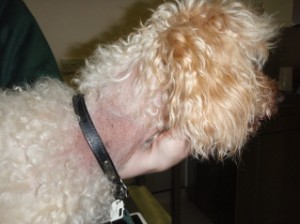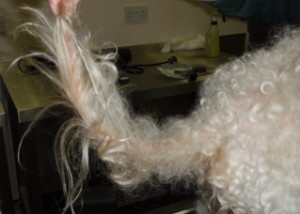Hypothyroidism in Dogs
Hypothyroidism is a common disease in dogs, and is caused by low levels of the hormone thyroid. It has a range of symptoms and can be challenging to diagnose, but is easily treated and the long term prognosis is very good.
What is Hypothyroidism?
- Hypothyroidism is a very common hormonal disorder in dogs.
- It is caused by low levels of the hormone thyroid, which is produced by the thyroid gland.
- Thyroid controls the speed of the metabolism, so dogs with very low thyroid levels have a slow metabolic rate.
- It occurs mainly in dogs over the age of 5, and there are some breeds, for example Golden retrievers, Irish Setters and Dobermans which are more prone to the disease.
- It is very rare in cats, who more commonly have Hyperthyroidism, an over active thyroid gland. To learn more about this, click here.
What causes Hypothyroidism?
- 95% of cases of Hypothyroidism are caused by a problem in the thyroid gland itself.
- In about 50% of these cases the gland stops working due to autoimmune attack. This means the body’s immune system starts to destroy the gland
- In the other 50% of dogs the glands suffer from ‘idiopathic atrophy’, which means the reason why the gland is destroyed is not known
- In a minority of cases, it can be caused by a cancer of the thyroid gland, but this is very rare.
- In a small number of cases, 5%, the problem is not with the gland itself, but can be with the hormonal signals coming from the brain which turn the gland on.
What are the symptoms of Hypothyroidism?
- Hypothyroidism is most commonly seen in young to middle aged dogs, generally they are between the ages of 3 and 5 years old.
- Pedigree dogs are at more of a risk of developing the disease, and certain breeds seem to be predisposed to developing it. These breeds include, Golden Retrievers, Dobermans and Irish Setters.
- The sympoms often come on over a period of time, which means they can be difficult to spot at first.
- The signs of the disease can be varied;
- Skin and coat changes;
- Dry, brittle coat and scurfy skin - these often occur very early in the onset of the disease.
- Hair loss - this happens gradually, and often the dog’s coat will thin before the hair starts to fall out. The lack of thyroid means the hair growth cycle is stopped, so when the hair falls out it is not replaced
- The hair loss occurs first in areas that are exposed to friction, for example on the neck, if the dog wears a collar
- Another classic sign of hypothyroidism caused by hair loss is ‘Rat Tail’. The hair on the tail thins, and they can end up bald.
- The hair loss can progress to have ‘bilaterally symmetrical’ patten on the flanks. This pattern of hair loss is typical in hormonal disorders.
- Skin infections are also common, and can reccur despite treatment with anti-biotics. Recurrent skin infections are often one of the reasons your vet will test for hypothyroidism.
- Lethargy and weight gain;
- Affected dogs show symptoms similar to people with under active thyroid glands. They can become quiet and dull. They are also less able to exercise, and tire more easily.
- They will often gain weight, and can become obese despite being fed a normal amount.
- Neurological changes;
- These are very variable and rarely occur without the other symptoms above as well.. They range from dullness and lethargy due to muscular weakness, to stroke-like symptoms. These include a head tilt, the eyes flicking from side to side, loss of balance and facial paralysis.
- Skin and coat changes;


This dog is showing typical hair loss changes of a Hypothyroid dog. there is scant hair on the tail ( Rat Tail) and also balding on the neck where the collar has been rubbing.
How is Hypothyroidism diagnosed?
Diagnosing Hypothyroidism can be challenging, as often dogs with other illnesses or problems will have low thyroid levels anyway. Diagnosis is based on compatable clinical signs, coupled with blood tests.
Health Screening Bloods
- It is important to take general health screeining bloods in any dog suspected of having Hypothyroidism, before any tests on the thyroid are performed.
- These will help to rule out any other complicating illnesses
- Changes seen on these blood tests which can point towards Hypothyroidism include;
- High Cholesterol
- Mild anaemia ( low levels of red blood cells)
Thyroid Blood tests
- There are several different blood tests vets can test the levels of thyroid in your dogs system;
- Total T4 - this is the most simple of these tests, it measures the total level of thyroid in the blood. A normal result means it is very unlikley a dog is Hypothyroid but a low result does not definitely diagnose the disease. Many other diseases can lower the total T4 in a dogs system without them actually being Hypothyroid.
- TSH - this is Thyroid Simulating Hormone. It is the hormone which raises the levels of T4 in the body. If the levels of T4 are low because the dog is Hypothyroid, the TSH will usually be very high.
- Free T4 - this is another way of measuring the thyroid levels. Free T4 is less affected than Total T4 by other illness. If a dog has a a low Total T4 but a normal TSH, Free T4 is a good tests to perform to confirm Hypothyroidism.
How is Hypothyroidism treated?
- Once diagnosed, Hypothyroidism is easily treated with daily tablets that replace the thyroid in the system.
- Tablets are normally given once daily in the morning.
- The active ingredient of the tablets is Thyroxine, a synthetic thyroid hormone which replaces the hormone the dog doesn’t have.
Tablets, usually given once daily in the morning, are the treatment for Hypothyroidism.
Monitoring Hypothyroidism
- It is very important that regular blood tests are taken to monitor the thyroid hormone levels.
- This allows your vet to ensure your pet is getting the correct dose of tablets and also to ensure the Thyroid hormone levels remain normal.
- Blood tests should be taken every 3-6 months.
- Blood tests are usually taken 4-6 hours after the dogs last tablet, which is why vets will normaly reccomend tablets are given in the morning.
Long term prognosis
- Once the correct doseage of tablets has been determined, dogs tend to remain very stable
- So long as the medication is continued for your dogs life, they should have as good a quality of life and also live as long as any normal dog.
Hypothyroidism can be a challenging disease to recognise and to diagnose, but once an affected dog is started on treatment, and the correct dosage found, the long term prognosis is extremely good.
Please note, this is an advice only website. If you have any specific queries or concerns about your pet, you should talk to your vet.